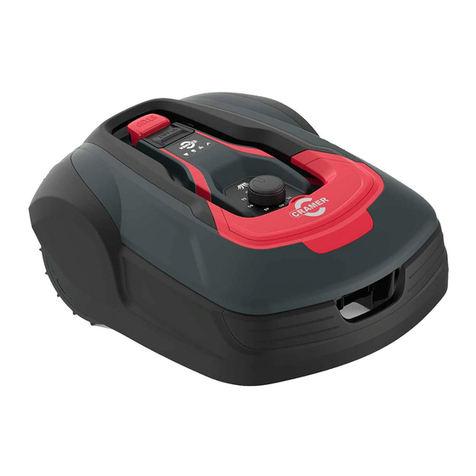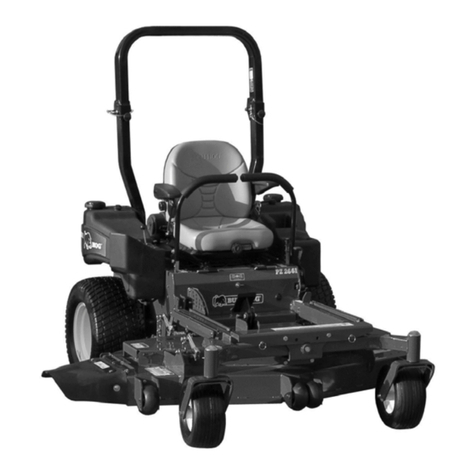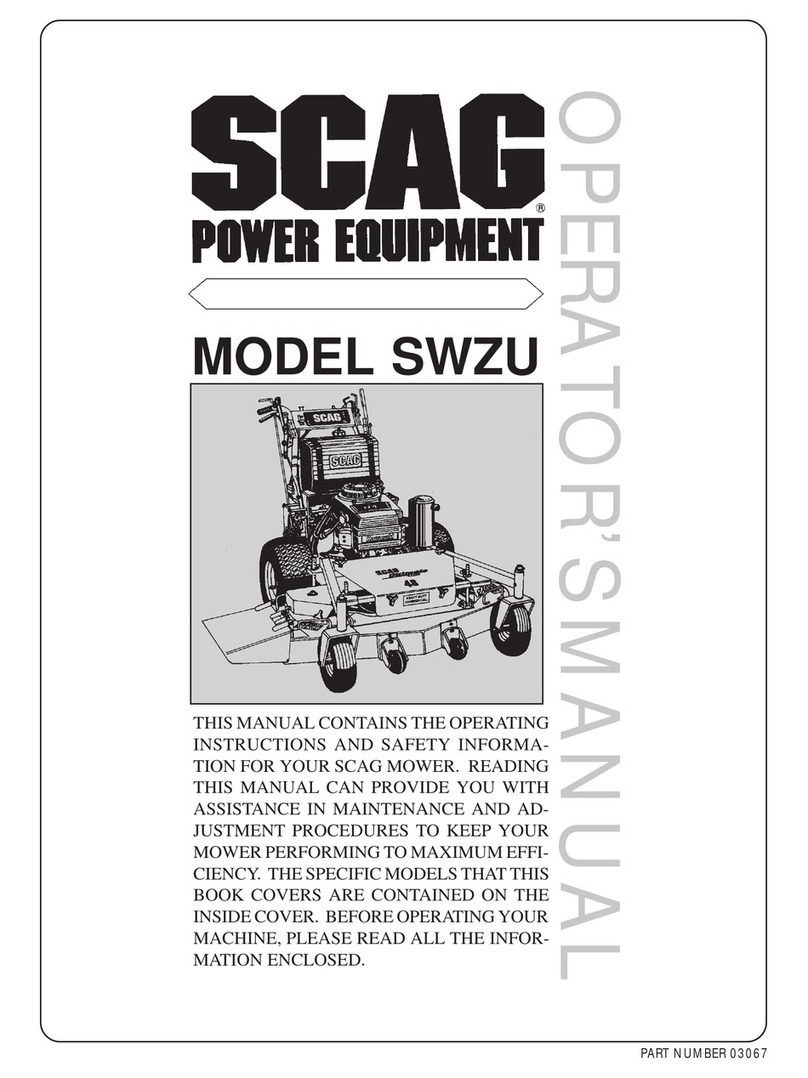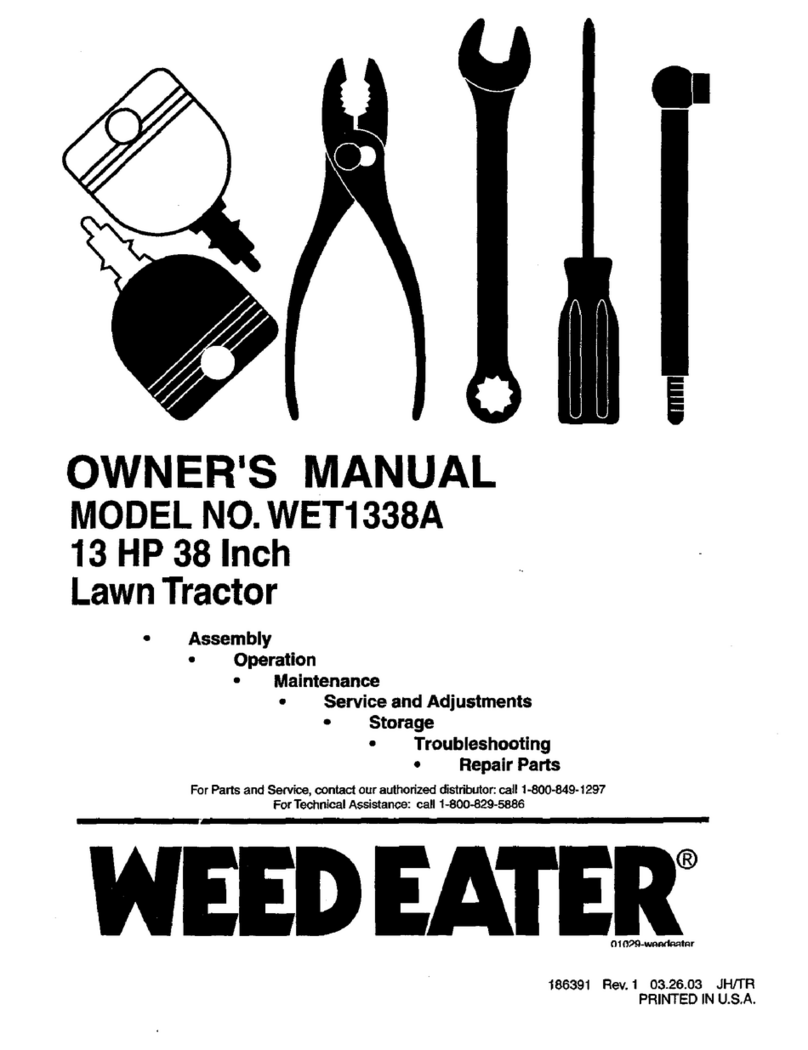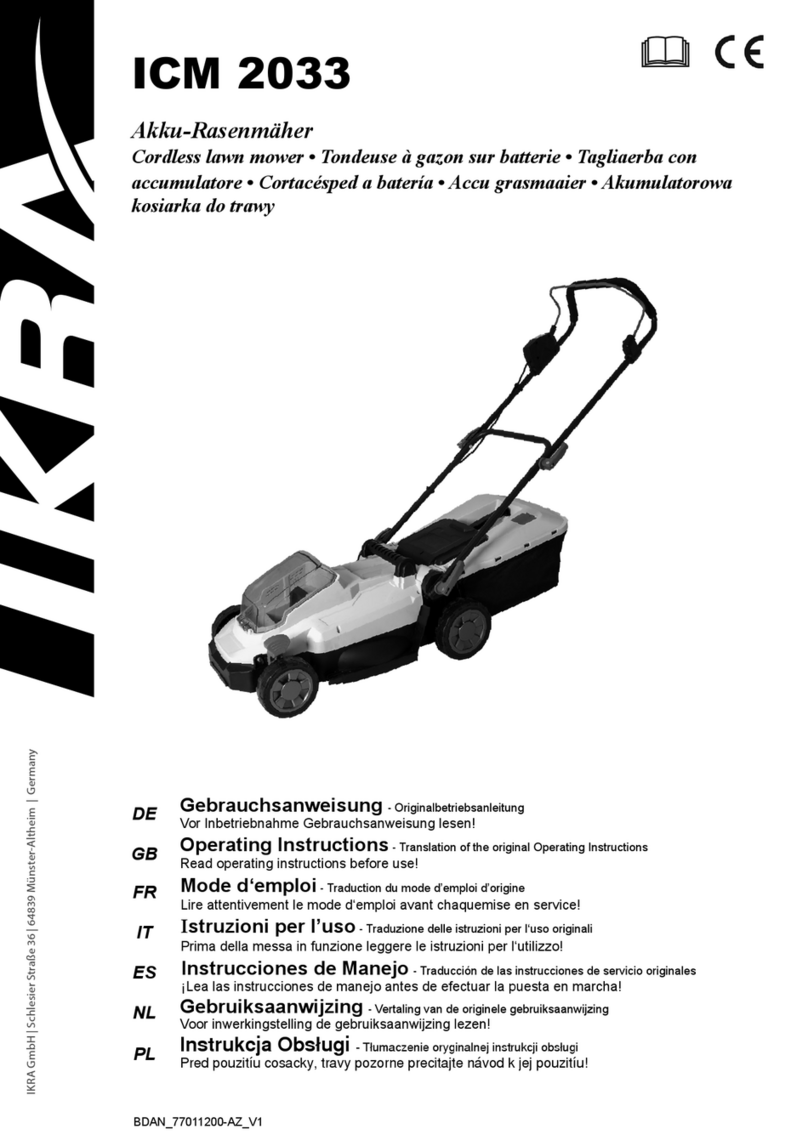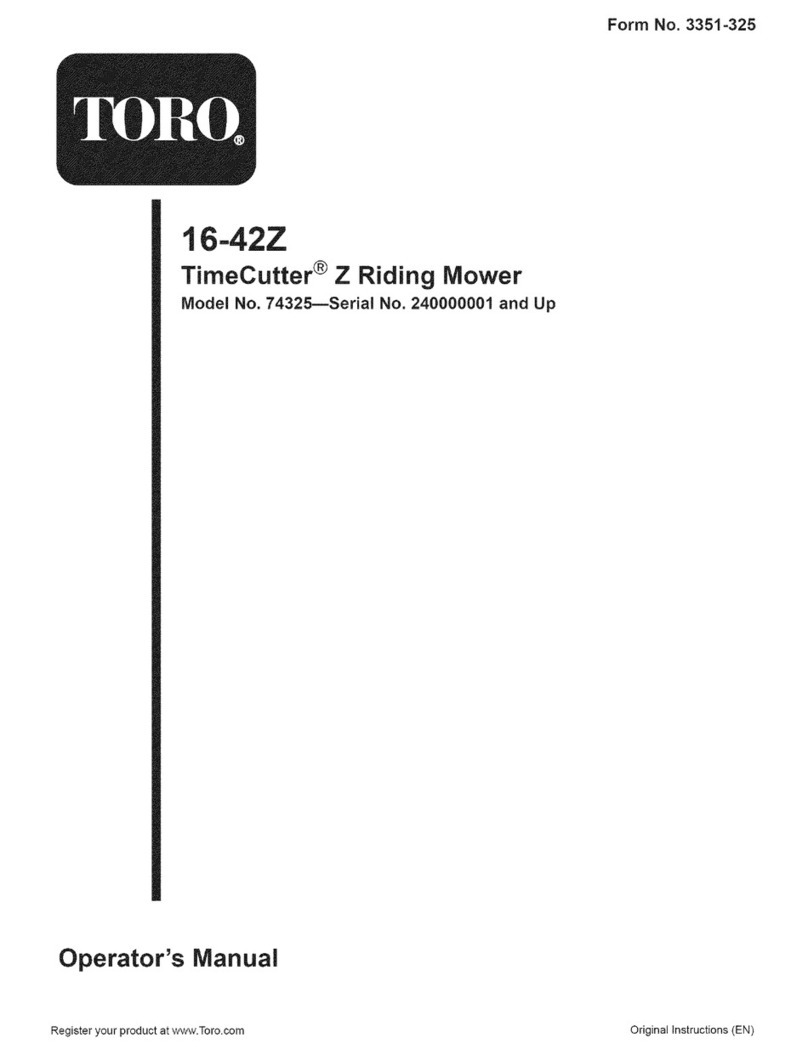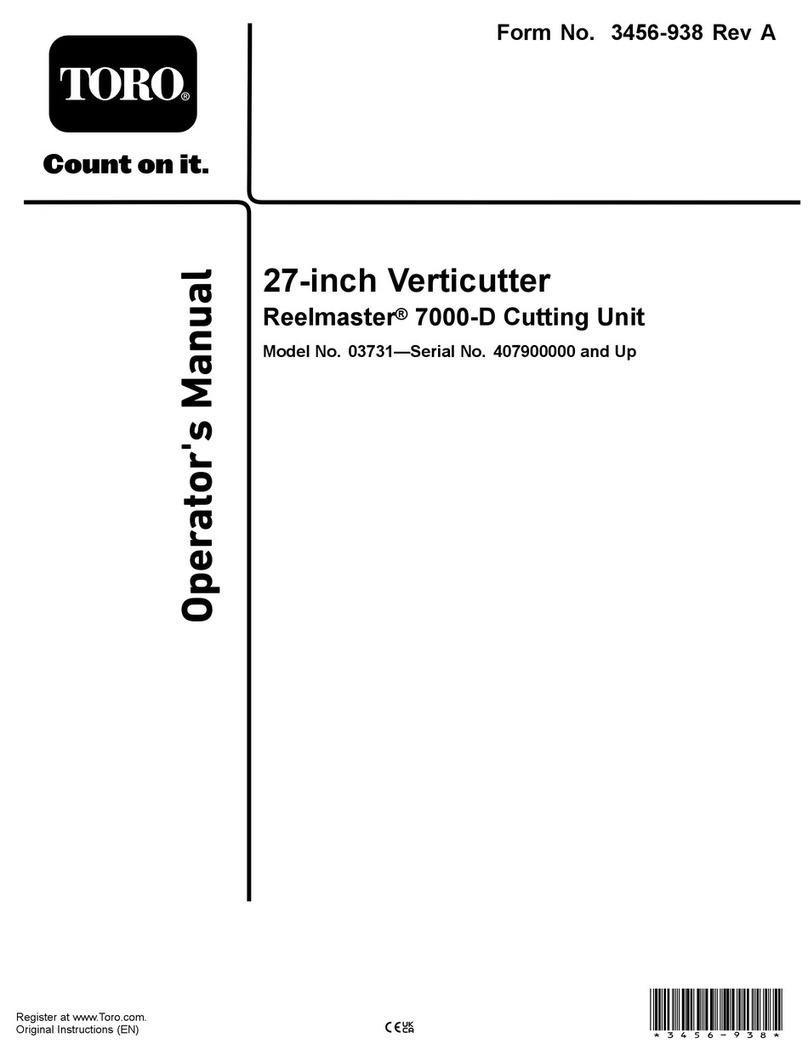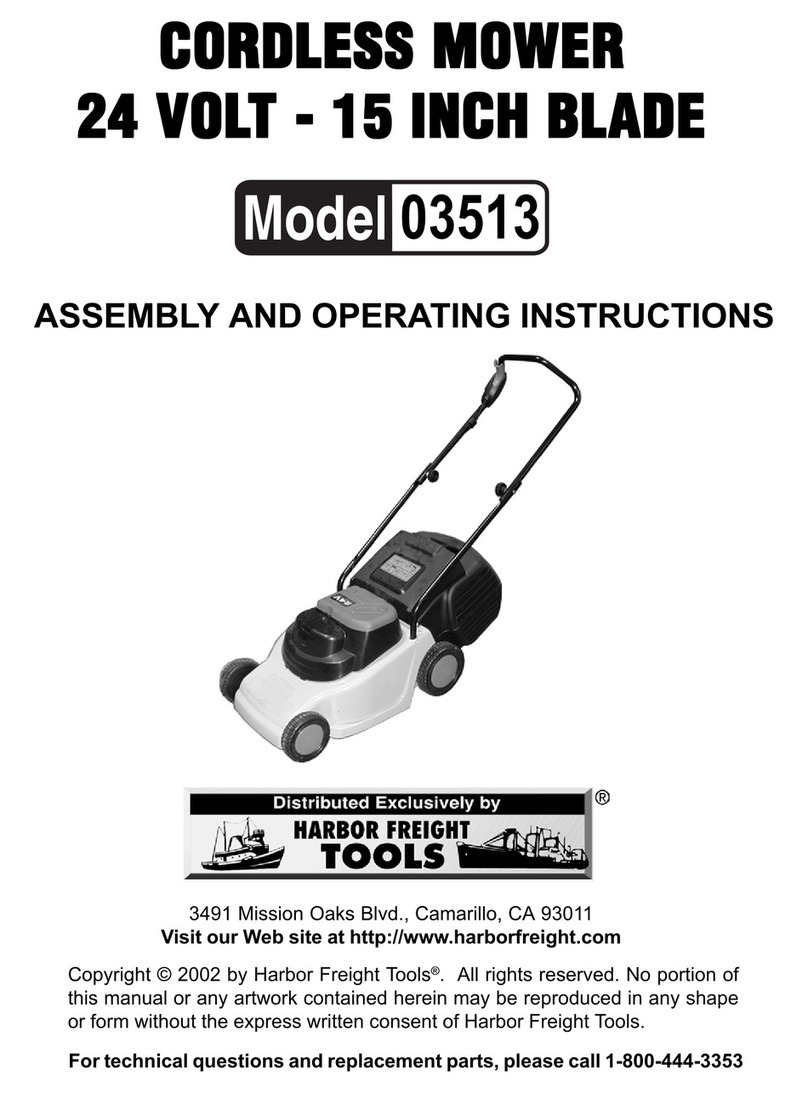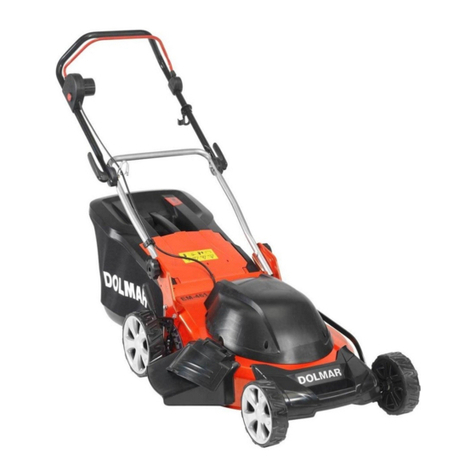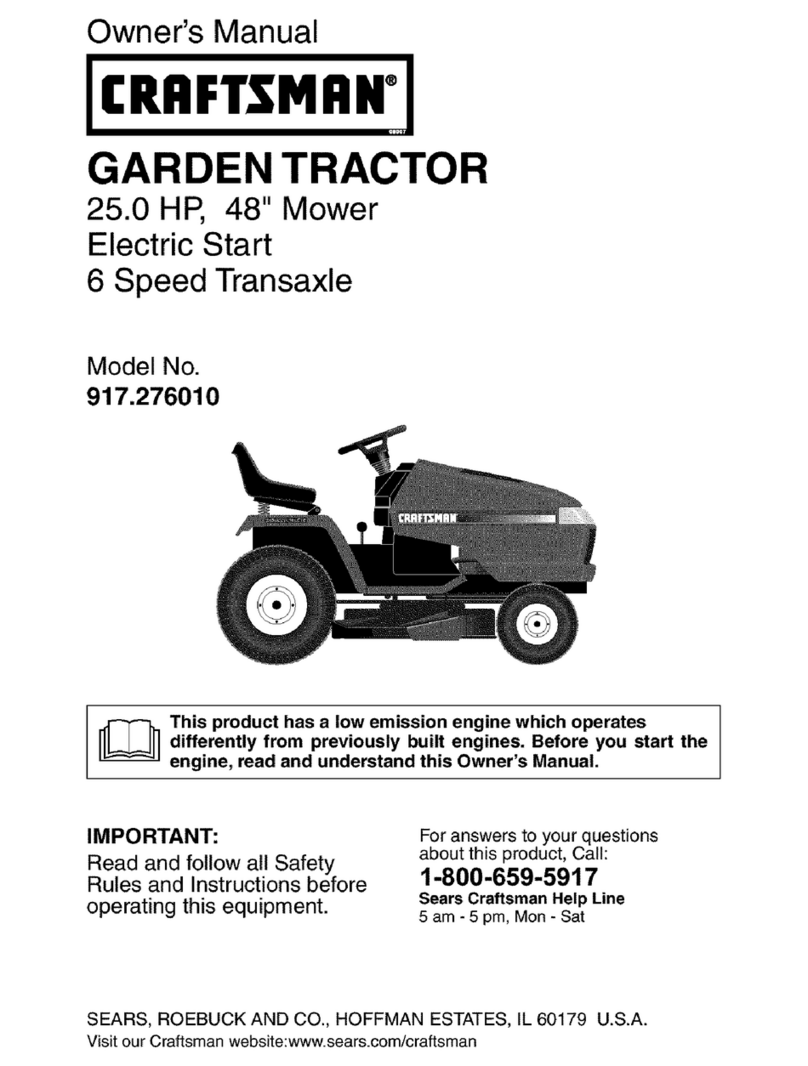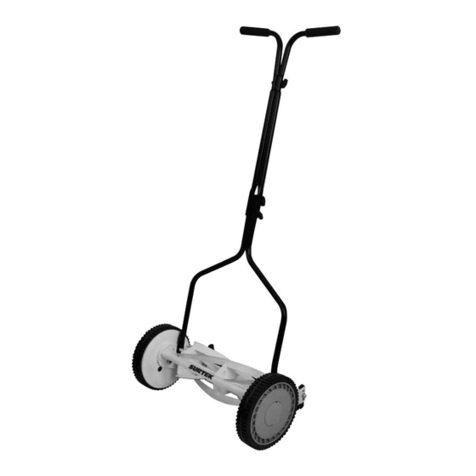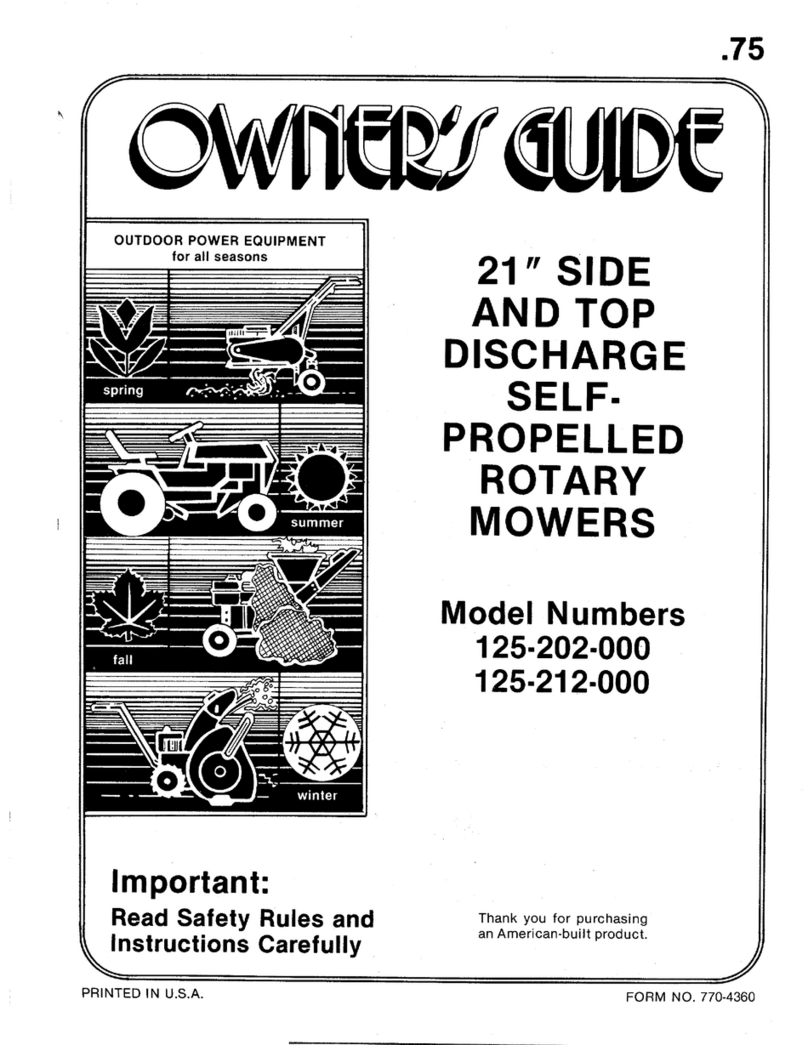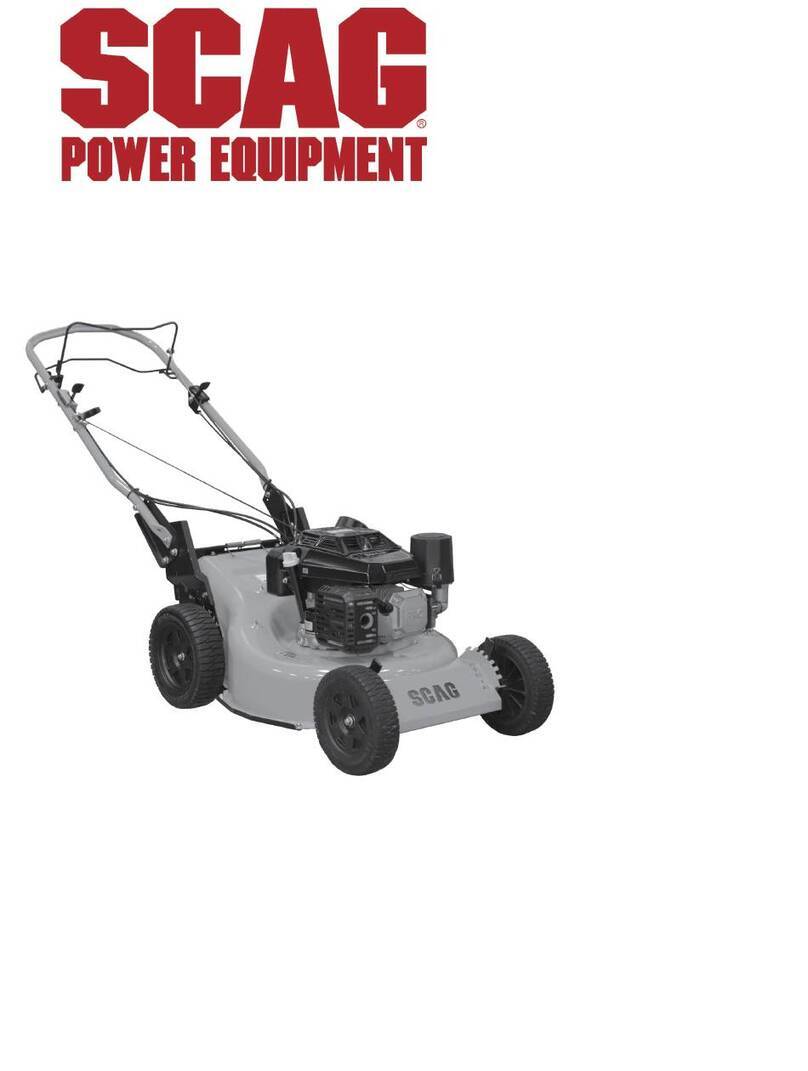Cramer 82ZT132 User manual

82ZT132 (7400486)
EN | FR | DE | SV | FI | DA | NO| ES | PT || IT |
| NL |
cramertools.com
P0803598-01, Rev B

Cramer information label for customer to connect phone to the vehicle via APP
(including QR code, paring code and serial number)

1 Description.........................................4
1.1 Overview........................................................... 4
1.2 Packing list........................................................ 4
2 Installation......................................... 4
2.1 Install the roll over protection structure
(ROPS)...............................................................4
2.2 Install the steering control lever........................ 4
2.3 Install the seat.................................................... 4
3 Know your machine.......................... 4
3.1 Electric take off (ETO) socket for
connecting accessories.......................................4
3.2 Control panel..................................................... 4
3.3 Steering control levers.......................................5
3.4 Safety start interlock system..............................5
3.5 ROPS (Roll Over Protective Structure).............5
3.6 Anti-scalp Wheels..............................................6
3.7 Neutral bypass knob.......................................... 6
3.8 Use the connectivity function............................6
4 Operation........................................... 6
4.1 Before operation................................................ 6
4.2 Operate the machine.......................................... 7
4.3 Slope operation..................................................8
4.4 App operation tips............................................. 8
5 Operation suggestions.......................9
6 Electrical system.............................. 11
6.1 Electrical system safety................................... 11
6.2 Electrical system information.......................... 11
6.3 Battery and charger..........................................11
6.4 Digital display..................................................12
7 Maintenance.....................................13
7.1 Mower blade maintenance...............................13
7.2 Tires................................................................. 13
7.3 Lubrication.......................................................14
7.4 Torque values...................................................14
7.5 Seat belt maintenance...................................... 14
7.6 ROPS maintenance..........................................14
7.7 Battery pack maintenance................................14
7.8 Service............................................................. 15
8 Cleaning and storage.......................15
8.1 Clean the machine........................................... 15
8.2 Store the machine............................................ 15
9 Troubleshooting...............................16
10 Technical data..................................17
11 Limited warranty............................ 17
11.1 What is covered by this warranty.................... 17
11.2 Who must perform the warranty service......... 18
11.3 What is not covered by this warranty.............. 18
11.4 Disclaimer of warranty.................................... 18
11.5 Limitation of remedies.....................................18
11.6 Time limit........................................................ 18
11.7 No other warranties......................................... 18
11.8 Owner's responsibility..................................... 18
11.9 Allocation of risks........................................... 19
11.10 Warranty registration....................................... 19
12 EC Declaration of conformity........ 19
3
English EN

1 DESCRIPTION
1.1 OVERVIEW
See separate figure sheet 1-12
1ROPS (Roll Over
Protective Structure)
2Steering control
levers
3Safety belt
4Left control panel
5Right control panel
6Height adjustment
lever
7Deck
8Discharge chute
9ETO socket
10 Charging port
11 Key of battery pack
protection
12 Anti-scalp wheels
13 Front wheel
14 Drive wheel
15 Attachment port
16 Digital display
17 Push button switch
18 High/Low for driving
speed
19 ON/OFF for blade
(PTO)
20 Power ON/OFF for
accessory (ETO)
21 High/Low for blade
speed
22 Clevis pin
23 R-pin
24 Thumb screw
25 Neutral bypass knob
26 Upper control lever
28 Lower control lever
29 Seat adjustment lever
30 Cyclone float knob
31 Deck height
adjustment pin
32 Quick charging port
33 Standard charging
port
34 Port cover
35 Mulching blade
36 Mulching cover
37 Side mulcher plate
38 Blade motor
39 Cutting blade
40 Side discharge chute
41 Seat plug
42 Magnetic bar
1.2 PACKING LIST
See figure 0
1. Unassembled machine
(1)
2. Upper handle
assembly (1)
3. ROPS assembly (1)
4. Seat assembly (1)
5. Blade assembly (1)
6. Discharge chute
assembly (1)
7. Charger (1)
8. Owner's manual (2)
9. Figure sheet (1)
2 INSTALLATION
2.1 INSTALL THE ROLL OVER
PROTECTION STRUCTURE
(ROPS)
See figure 3
1. Insert the celvis pin into the hole.
2. Insert the R-pin into the hole on the celvis pin.
2.2 INSTALL THE STEERING
CONTROL LEVER
See figure 4
1. Align the upper control handle with the lower control
handle.
2. Insert the screw together with the washer into the hole.
2.3 INSTALL THE SEAT
See figure 5
1. Place the seat assembly over the mounting brackets and
align holes as shown.
2. Connect the seat plug (41) to the machine.
3. Install the bolts, washers and nuts and tighten securely.
4. Make sure it is securely seated.
3 KNOW YOUR MACHINE
3.1 ELECTRIC TAKE OFF (ETO)
SOCKET FOR CONNECTING
ACCESSORIES
See figure 1 (Point 9)
The machine can be used together with other attachments
such as the blower.
3.2 CONTROL PANEL
3.2.1 LEFT CONTROL PANEL
See figure 2
#Name Function
16 Digital dis-
play
This display shows important electrical
system information. Refer to the Electri-
cal section for complete information.
17 Push button
switch (See
figure sheet
picture 2)
On/off. With magnetic bar inserted, press
the push button switch to activate the
machine; press the push button switch
again to stop the machine
3.2.2 RIGHT CONTROL PANEL
See figure 2
4
English
EN

# Name Function
18 High/Low
for driving
speed
Allows operators to select a comfortable
driving speed. Pressing it to “High
Speed"” position means that the maxi-
mum drive speed will be 16 KM/H.
Pressing it to “Low Speed” position
means that the maximum drive speed
will be 9 KM/H. Press it to “Low Speed”
position for inexperienced operators or
when trimming around objects, buildings
and other obstacles.
NOTE
Get comfortable with mower before us-
ing “High Speed” setting. The maxi-
mum speed may be adjusted at any
time, whether the mower is in motion
or not.
19 ON/OFF for
blade (PTO)
This switch engages the blade motors.
Pull the switch up to engage and push
switch down to disengage the motors.
20 Power
ON/OFF for
accessory
(ETO)
The machine can be used togheter with
other attachments and accessories.
21 High/Low
for blade
speed
The user can choose between two cutting
modes. High blade speed mode and low
blade speed mode. Selection is depend-
ent on grass enviroment.
NOTE
Mowing time will be increased when
mowing in low blade mode.
IMPORTANT
Never engage blade motors when the deck is under load.
Motors or deck could be damaged.
3.3 STEERING CONTROL LEVERS
The two levers control the mower’s speed, direction,
stopping, neutral lock, and parking brake. Levers are used to
steer, accelerate, decelerate, stop, and change direction. When
the control levers are in the park brake position, the mower
will not move.
3.4 SAFETY START INTERLOCK
SYSTEM
The machine is equipped with a safety start interlock system
consisting of the parking brake switches, seat switch, and
PTO switch.
The mower’s safety start interlock system is also designed to
protect the operator and others from accidental injury due to
unintentional traction drive system starting.
Check mower safety start interlock system daily, prior to
operation. This system is an important mower safety feature.
It should be repaired immediately if it malfunctions. The
machine incorporates a separate seat switch which will stop
the drive system and blade motors when the operator is
unseated for any reason while the mower is operating. This is
a safety feature designed to prevent runaway or accidental
entanglement.
WARNING
The safety interlock system must not be disconnected or
bypassed. Doing so could cause the machine to operate
unexpectedly, resulting in personal injury.
To inspect the system:
1. The operator must be on the seat when testing the seat
switch.
2. Press the push button switch with magnetic bar inserted.
3. Pull the steering control levers to the neutral position.
4. Pull the PTO switch ON to engage the motor.
5. Slowly raise off of the seat. The deck blade system should
stop.
6. If the deck blade system fails to stop when the operator is
off of the seat and if the cause cannot be determined,
contact your Cramer dealer immediately.
3.5 ROPS (ROLL OVER PROTECTIVE
STRUCTURE)
A ROPS may minimize the Risk of injury or death from
rollover. The two-post ROPS can be pivoted down by
removing the clevis pins after pulling out on the R-pins so
that the machine can operate under low-hanging tree limbs or
other obstructions. Do not wear the seat belt when the ROPS
is in the lowered position. Use the ROPS in the “folded”
position only when it is absolutely necessary.
WARNING
Do not operate the mower with the ROPS folded (lowered
position) -- a standard operating mode. A folded ROPS does
not provide rollover protection.
WARNING
Always wear your seat belt unless the ROPS is folded
down. In this case, the seat belt should never be worn.
5
English EN

WARNING
To minimize chance of injury or death from rollover:
• Keep ROPS in the raised and locked position and use
the seat belt.
• Lower the ROPS only when absolutely necessary.
• Drive slowly and carefully. Raise the ROPS as soon as
clearance permits. Read and follow slope operation
instructions and warnings.
• Always fasten seat belt during operation of the machine
(mower equipped with ROPS in “raised/up” position).
• Inspect the area to be mowed for proper overhead
clearance (tree limbs, guy wires, doorways, etc.) Do not
contact any overhead object with the ROPS.
WARNING
Always pull from the Zero Turn hitch. Do not attach chains
or ropes to the ROPS for pulling purposes, as the machine
can tip backwards.
3.6 ANTI-SCALP WHEELS
See figure 2
Anti-scalp wheel kits are standard on Cramer units. These
anti-scalp wheels are designed to minimize scalping when
mowing on rough, uneven terrain. After setting the cutting
height, adjust the anti-scalp wheels so they extend below the
deck but do not contact the ground. They should always be at
least 0.6 cm to 1.9 cm below the deck. With the unit sitting on
a flat level surface, the wheel position can be adjusted up or
down as needed from 1.9 cm to 4.4 cm below the blade
surface. Move the wheels up or down - using the different
axle mount holes in the wheel mount bracket (if applicable on
model).
3.7 NEUTRAL BYPASS KNOB
See figure 7-8
1. Locate the Neutral Bypass Knobs behind the frame at the
rear of the mower.
2. Remove the (4) thumb screws holding in the mesh cover.
3. Remove the neutral bypass knob from its original location
and install it to the motor. Operate one or both of the
knobs on the motor, as needed.
4. Rotate the neutral bypass knobs clockwise to release
drive brakes; counterclockwise to engage.
5. Install the neutral bypass knob(s) back to its/their original
location after completing maintenance.
WARNING
Never drive mower with the neutral bypass knob working.
Always install the neutral bypass knob to the original
position before driving! Failure to re-install the knob could
cause serious damage to your mower and void mower
warranty!
WARNING
Never pull the neutral bypass lever outside when the
machine is working on the slope!
3.8 USE THE CONNECTIVITY
FUNCTION
The connectivity box software can provide the location and
data of the machine.
NOTE
If the connectivity box is damaged or removed, the machine
will go into limp home mode in which the machine can only
be drived in low speed without the blade working.
4 OPERATION
4.1 BEFORE OPERATION
4.1.1 ADJUST THE STEERING CONTROL
LEVER
The steering control levers can be adjusted for operator
comfort. By loosening the cap screws that attaches the upper
control lever to the lower lever, the upper control lever can be
pivoted to fit the operator’s personal preference. The steering
control levers should be adjusted so that they align with each
other when in the neutral position.
4.1.2 ADJUST THE SEAT
See figure 6
WARNING
Make sure seat pan is securely bolted down prior to each
use to prevent seat from moving/tilting in the event of
mower tipping or rollover.
The seat can be adjusted forward and rearward by moving the
latch under the seat. Move the latch to left and pull the seat
where you have the best control of the machine and are the
most comfortable and then tighten the safety belt.
NOTE
You can adjust the suspended pressure of the seat by turning
the cyclone float knob. Turn clockwise the preload will
increase and counterclockwise for the preload to reduce.
4.1.3 ADJUST THE DECK CUTTING
HEIGHT
See figure 9
Before using the mower, raise the deck height to the cutting
position best suited for your lawn.
Deck height is adjustable from 2.5-14 cm. Deck should be
raised while mowing is in progress to avoid stumps, rocks or
other obstacle that can be damage mower deck.
1. Stop the mower and disengage blades.
6
English
EN

2. Press the push button switch and set the parking brake.
3. Fully depress the deck height adjustment pedal.
4. Insert the pin once the desired deck height is available.
5. Fully depress the deck height adjustment pedal again.
4.2 OPERATE THE MACHINE
4.2.1 START THE MACHINE
WARNING
Seat belt must be fastened while operating a mower
equipped with ROPS in the raised and secured position. Do
not wear the seat belt when the ROPS is in the lowered
position.
1. With magnetic bar inserted, press the push button switch
to activate the machine.
2. Check for the appropriate speed mode by pressing drive
speed control button to “low speed” position.
NOTE
It is always recommended to start out in low mode/slow
speed.
3. Pull right and left drive control levers inward until stops
are contacted.
4. Pull up on deck PTO switch to start cutting blades for
mowing.
NOTE
Only engage blades when drive control levers are in the
NEUTURAL position! NEVER engage blades when
moving!
5. Push drive control levers forward for forward motion and
pull for reverse motion.
NOTE
Electric brake will engage after drive control levers are
returned to neutral.
4.2.2 DRIVE THE MACHINE
After starting the traction drive system, engage the steering
control levers and steer as follows:
WARNING
Always be aware of what is behind the machine before
backing up. Do not mow in reverse unless absolutely
necessary. Always look down and behind before and while
backing up.
WARNING
Rapid movement of steering control levers is not
recommended as damage to the electrical system
components may occur.
•To go forward, push steering control levers forward an
equal distance.
•To go in reverse, pull steering control levers rearward an
equal distance.
•To turn left, move the right steering control lever farther
forward from neutral than the left steering control lever.
•To turn right, move the left steering control lever farther
forward from neutral than the right steering control lever.
•To execute a zero-radius turn, move one steering
control lever forward and the other steering control lever
back of neutral. This will allow the drive wheels to
counter-rotate.
•To stop or decrease speed, move steering control levers
to neutral. When going forward, pull back gently on
steering control levers. When going in reverse, push
forward gently on steering control levers.
•For an emergency stop, there are two methods that can
be used:
• When traveling forward or in reverse, place the
steering control levers in the park brake position
immediately. When moving in the rearward direction,
push forward gently on steering control levers and
avoid sudden movement. Any sudden movement
could cause the front of the mower to come off of the
ground, resulting in possible loss of control, thereby
causing serious injury or death.
• Press the push button switch and remove the
magnetic bar. This will shut down the traction drive
system and the deck drive system.
•To make a three-point turn to the right, move the left
steering control lever farther forward from neutral than
the right steering control lever and start the turn. Next,
pull back on the steering control levers until they are past
neutral and the machine starts to go rearward. Pull the
right steering control lever farther rearward from neutral
than the left steering control lever until the rear of the
machine has pivoted around. Then, push the steering
control levers forward until they are both past neutral and
the machine starts to go forward. Push the left steering
control lever farther forward from neutral than the right
steering control lever and finish the turn.
•To increase speed, increase steering control lever’s
distance from neutral. The farther forward steering
control levers are from neutral, the faster the machine will
travel forward. The farther back steering control levers
are from neutral, the faster the machine will go in reverse.
7
English EN

4.2.3 STOP THE MACHINE
DANGER
Never make sudden stops or reverse direction, especially
when maneuvering on a slope. The steering is designed for
sensitive response. Rapid movement of the steering control
levers in either direction could result in a reaction of the
machine that can cause serious injury.
1. Return drive control levers to the Neutral position. Push
drive control levers outward into park brake position.
2. Push down on deck blades ON/OFF to turn off the blades.
3. Press the push button switch.
CAUTION
It is recommended to remove the magnetic bar from the
machine to prevent accident start of the machine.
4.3 SLOPE OPERATION
• Use extreme caution when operating on slopes.
• Do not remove or modify any wheels.
• Watch for holes, ruts, bumps, rocks or other hidden
objects. Uneven terrain could overturn the machine. Tall
grass can hide obstacles.
• Remove obstacles such as rocks, tree limbs, garbage etc.
• Keep all movement on slopes slow and gradual. Do not
make sudden changes in speed or direction.
• Avoid starting and stopping on a slope. If tires lose
traction, disengage the blades and proceed slowly straight
down the slope.
• Mow a safe distance (minimum of 3 meters) away from
drop-offs, retaining walls, drainage ditches,
embankments, water, and other types of hazards to avoid
a wheel dropping over the edge or the ground breaking
away. This will reduce the risk of the machine suddenly
rolling over, which could cause either serious injury or
death.
• Use a walk-behind, push mower or hand-held trimmer on
slopes and near drop-offs, retaining walls, drainage
ditches, embankments and water.
• Do not mow on wet grass. Reduced traction could cause
sliding and loss of steering control.
• Do not tow on slopes. The weight of the towed equipment
may cause loss of traction and control.
• If the mower’s tires lose traction when operating on
slopes, disengage the deck drive, place the steering
control levers in the park brake position, press the push
button switch, remove the magnetic bar and get help.
• Never make sudden starts, stops, turns, or reverse
direction, especially when maneuvering on slopes. The
steering is designed for sensitive response. Rapid
movement of the steering control levers in either direction
could result in a reaction of the machine that can cause
serious injury.
• Never stop suddenly while backing down slopes. This
action may result in a reaction of the machine that can
cause serious physical injury.
• The Cramer mower is capable of operating horizontally
(traverse) on moderate slopes. When operating on slopes
up to 20 degrees, be aware of any conditions that may
cause the mower drive tires to lose traction, resulting in a
possible loss of control of the machine. An operator
should not operate on a slope until he is thoroughly
familiar with the equipment.
Do not operate on slopes greater than 20 degrees.
Refer to Slope Guide, when determining the degree of
slope to be mowed. It is strongly recommended that the
operator drive the machine off of the slope, using extreme
caution, if any sign of loss of traction is detected. Wait
until the condition that caused the problem is resolved
before attempting to operate on the slope again. Terrain
conditions can affect traction, resulting in possible loss of
control of the machine. Some of the conditions to be
aware of are:
1. Wet terrain
2. Depressions in the ground (e.g., holes, ruts, washouts)
3. Mounds of dirt
4. Certain types of soil (e.g., sand, loose dirt, gravel,
clay)
5. Grass type, density, and height
6. Extremely dry conditions
7. Tire pressure
The attachments mounted to the mower will also affect
the way it handles on a slope. Be aware that each
attachment’s characteristics vary.
These are just a few examples of situations where caution
must be used when operating on a slope. There are many
other possibilities too numerous to mention. Remember to
always exercise extreme caution while operating on any
slope.
• The ROPS may minimize risk of injury or death from
rollover. Seat belt must be fastened while operating a
mower equipped with ROPS in the raised and secured
position. Both retaining pins and hair pins must be
installed. Failure to use seat belt with ROPS will result in
serious injury in the event of a rollover.
4.4 APP OPERATION TIPS
1. MOBILE APPLICATION
See separate figure sheet 13
Find the serial number, pairing code and QR code in the
vehicle matching label.
2. REGISTRATION AND LOGIN
See separate figure sheet 14
Step 1. Fill in the registration information (with * is
required), and then click the "Create" button.
8
English
EN

Step 2. Confirm User Rights. Give information usage
consent.
Step 3. Confirm End User License Agreement. Click "Create
account".
Step 4. Activate the account email, click "Continue". Open
the email and click the activation link in it, and then continue
to log in.
Step 5. Log in.
3. ADD A DEVICE
See separate figure sheet 15
Step 1. Click "Pair your mower" to add a device of Cramer
machine.
Step 2. Find category of vehicle according to your device
type, then click button “Pair” (Vehicle).
Step 3. Select your pairing method - "Scan QR code" or type
in "Serial number and pairing code".
Step 4. When you select option "Serial number and paring
code", just manually input serial number + paring code.
Step 5. Click "Finish" to end the procedure or click "Set up
protective measurements" to continue.
4. GPS FUNCTION
(1) Upload data
See separate figure sheet 16
Connect your mobile phone to the APP, and you can check
fault, speed, and battery power of the machine through the
APP.
(2) GPS
See separate figure sheet 17
The machine is equipped with GPS function, you can connect
your mobile phone to the machine by the APP. It is
convenient to locate your machine and achieve anti-theft
effect.
This icon shows the position where the vehicle was last
connected on map. When click vehicle icon, it will show the
device’s name, latest latitude and longitude. You can click the
copy icon to copy the value of latitude and longitude.
WARNING
The 4G & GPS connectivity device may lose the GPS
satellite signal or cellular connection at any time. Due to
heavy tree canopies, large buildings, poor weather
conditions, electrical interference, dead zones, or other
obstacles.
5 OPERATION SUGGESTIONS
DANGER
Prior to operation, the operator should be thoroughly familiar with the proper use and operation of the equipment, should read
the manual completely and thoroughly, and should have attempted slow moving maneuvers to become familiar with the
operation of the equipment before attempting normalspeed operation. An inexperienced operator should not mow on slopes or
on uneven terrain.
9
English EN

WARNING
If you lose steering control while operating the machine, place the steering control levers in the park brake position
immediately, press the push button switch and remove the magnetic bar. Inspect the machine and consult your Cramer dealer to
resolve the problem before continuing to operate.
WARNING
The unit’s steering control levers are very responsive. For smooth operation, move levers slowly, avoiding sudden movements.
Skill and ease of operation come with practice and experience. The machine can spin very rapidly. Use caution when making
turns and slow down before making sharp turns.
Inexperienced operators may have a tendency to oversteer and lose control. Slow-moving practice maneuvers are recommended
to become familiar with these characteristics before attempting normal-speed operation.
WARNING
Sharp depressions or raised obstacles (such as gutters or curbs) should not be directly approached at high speed in an attempt to
“jump” them as the operator could be thrown from the equipment. Approach at a slow speed and angle one drive wheel at the
obstruction. Continue at an angle until the wheel clears and then pivot the opposite wheel around.
When turning on soft or wet turf, keep both wheels rolling either forward or backward. Pivoting on one stopped wheel can
damage turf. Keep blades sharp. Many problems with incorrect cutting patterns are due to dull blades or blades which have been
sharpened incorrectly. Blade sharpness should be checked daily.
DANGER
Never service the machine while magnetic bar is inserted. Always pull out the magnetic bar when you are going to work with
the machine. Always place deck blade switch in the disengaged position, place steering control levers in the park brake
position and remove the magnetic bar from switch. Block up mower when you must work under it. Wear gloves when handling
blades. Always check for blade damage if mower strikes a rock, branch, or another foreign object during mowing.
•Direct grass discharge to right, away from unmowed area. Select a mowing pattern that directs grass discharge towards the
outside the mowing area. Generally, this means using a pattern utilizing left turns because side discharge is to the right. In
any case, avoid throwing grass discharge onto unmowed area because grass is then mowed “twice.” Mowing twice puts an
unnecessary load on the unit and reduces mowing efficiency.
•When mowing a lawn for the first time, cut grass slightly longer than normal to avoid scalping uneven terrain. When
possible, it is best to use the cutting height that was used in the past. When cutting grass taller than six inches, you may want
to mow the lawn twice to achieve a better quality of cut.
•During normal mowing, cut only about 1/3 of the grass. Cutting more than that is not recommended unless grass is sparse
or it is the end of the mowing season.
•Alternate mowing pattern between cuts to keep the grass growing straight and better dispersion of the clippings.
•Remember, grass grows at different rates at different time of the year. Mow more often in the early spring to maintain the
same cutting height. As the growth rate slows in mid summer, mow less frequently. If you cannot mow at a regular interval,
mow at a high cutting height at first, then mow again two days later at a lower cutting height.
•Raise the cutting height of the mower if the cutting width of the mower is wider than the previous mower. This ensures
that uneven turf is not cut too short.
•Raise the cutting height of the mower if the grass if slightly taller than normal or if it contains a high degree of moisture.
Then mow it again with the cutting height set lower.
•This mulching system permits easy breakdown of the grass clippings and returns grass clippings back to the soil. For the
best mulching results, you never let your grass grow more than 1/3 longer than your desired height. When your grass reaches
that height, you cut the top 1/3 away.
•If the machine’s forward motion must be stopped while mowing, a clump of grass clippings may drop onto your lawn. To
avoid this, move onto a previously cut area with the blades engaged.
•Charge the battery immediately.
10
English
EN

Model No. Battery capacity Action Battery capacity Action
82ZT132 3% - 6%
The maximum drive speed
will be 9 km/h and the unit
will operate in lower blade
speed mode.
<3%
The working blade will
stop automatically. The unit
should immediately be re-
turned to the battery charg-
ing area and the unit con-
nected to the battery charg-
er.
•Allow motors 30 minutes to cool down. If drive motor exceeds programmed temperature, the motor speed will decrease. If
temperature continues to increase, drive will shut down at a higher programmed temperature.
6 ELECTRICAL SYSTEM
6.1 ELECTRICAL SYSTEM SAFETY
• Remove the magnetic bar, disconnect battery cables by
pulling inward on RED battery quick disconnect handle
in battery box compartment and read owner’s manual
before adjusting or repairing unit.
• Always remove the magnetic bar and disconnect battery
cables by pulling inward on RED battery quick
disconnect handle in battery box compartment before
working on this unit.
• Always disconnect battery cables by pulling inward on
RED battery quick disconnect handle in battery box
compartment when transporting unit.
• Keep unit free of grass clippings, leaves and other debris.
DO NOT spray water to clean unit. Use only compressed
air. Wear adequate eye and hearing protection when
cleaning the unit.
• Always wear safety glasses and protective gear near
battery. Use insulated tools.
• Clean battery compartment, drive motor compartment,
mower deck, seat, etc., of all dirt and debris. Do not use
solvents, hard cleaners or abrasives.
• When the power switch activated, mower blade can
engage when deck blade ON/OFF switch is engaged,
even if drive motor is not turning. Keep area clear of
bystanders when engaging deck blade ON/OFF switch.
• All maintenance and storage areas should be properly
ventilated in accordance with applicable fire codes and
ordinances to avoid fire hazards. Proper ventilation is
required to remove hydrogen gas from the area during
battery charging.
• Never allow flames, sparks or smoking near batteries.
• Keep batteries out of reach of children.
• Always keep protective shields, covers and guards in
place and securely fastened. If they become damaged,
repair or replace immediately. Never modify or remove
safety devices.
6.2 ELECTRICAL SYSTEM
INFORMATION
The Cramer mower is powered by an 82-volt electrical
system. It consists of the following components:
1. Blade controller (3) (Depending on model)
2. Blade Motor (3) (Depending on model)
3. Drive controller (2)
4. Accelerator - right (1)
5. Accelerator - left (1)
6. Digital display (1)
7. Motor drive assembly (2)
8. Battery pack (1)
6.3 BATTERY AND CHARGER
WARNING
Maintenance for the various electrical components found on
the Cramer Mower should only be performed by a Cramer
Mower trained technician.
WARNING
When battery voltage becomes low, the mower blades will
stop, although the drive motors will continue to run,
enabling driver to continue to drive unit. When the batteries
discharge to this point, they require recharging. The unit
should immediately be returned to the battery charging area
and the unit connected to the battery charger.
WARNING
Do not attempt to cross roads or railways with low battery
levels.
6.3.1 BATTERY CHARGING PORT
See figure 10
The battery charging port is located on the right (with
operator seated) housing of the machine. Open the port cover
to charge. Both quick charging port and standard charging
port are available.
11
English EN

6.3.2 CHARGING RECOMMENDATIONS
WARNING
Do not smoke while servicing the batteries.
WARNING
Always wear safety glasses and protective clothing near
battery. Use insulated tools.
CAUTION
Charging recommendations
• Battery packs do not develop a memory and need not be
fully discharged before recharging.
• Batteries left uncharged will slowly discharge. Before
initial use each spring season, be sure batteries have a
full charge before mowing.
• If charger is not left plugged in, the batteries should be
fully charged every 30 days to maintain battery life.
Never allow charger to charge more than 15 hours.
• When charging, be sure charger cooling fan inlet and
outlet are not blocked.
6.3.3 CHARGE THE BATTERY
WARNING
More details of charger are referred to in the charger
manual. Read and understand all its safety warnings and
instructions. Failure to follow them may result in electrical
shock, fire and/or serious injury.
1. Press the push button switch.
2. Remove the magnetic bar and make sure the machine
comes to a complete stop.
3. Remove the dust cap from the battery charging port on
the mower.
4. Plug the charger into the port.
5. Plug other end of charger into household GFCI protected
outlet.
WARNING
Always turn charger “OFF” before disconnecting charger
from mower. Disconnect charger cord from wall outlet.
WARNING
Cover the battery charging port with the dust cap before
operation.
6.4 DIGITAL DISPLAY
The function of the digital display, located on the control
panel, is to provide electrical system information to the
operator. It gives detailed information in the form of pattern,
codes and number.
6.4.1 DIGITAL DISPLAY (FOR 82ZT132
SERIES)
# Name Function
1 Low drive speed
2 High drive speed
3 Seat switch
4 Left control lever
5 Right control lever
6 PTO switch
7 The whole machine is OK
8 Need to restart
9 Low blades speed
10 Blade working
11 Battery remaining capacity
12 Total hours Total working hours
13 Overall sta-
tus
Overall status
14 Cutting
hours
Cutting hours
15 L Left blade motor fault code
A Master controller fault code
BMS Battery fault code
R Right blade motor fault code
B Slave controller fault code
M Middle blade motor fault code
12
English
EN

7 MAINTENANCE
Regular maintenance is the best prevention for costly
downtime or expensive, premature repair. The following
pages contain suggested maintenance information and
schedules which the operator should follow on a routine
basis. Remain alert for unusual noises, as they could be
signaling a problem. Visually inspect the machine for any
abnormal wear or damage.
7.1 MOWER BLADE MAINTENANCE
Check the mower blades daily. They are the key to power
efficiency and well-groomed turf. Keep them sharp -- a dull
blade will tear rather than cut the grass, leaving a brown
ragged top on the grass within a few hours. A dull blade also
requires more power. Replace any blade that is bent, cracked
or broken.
WARNING
Never attempt to straighten a bent blade by heating, or weld
a cracked or broken blade as the blade may break and cause
serious injury. Replace worn or damaged blades.
WARNING
Never work with blades while magnetic bar is in the
ignition switch. Remove magnetic bar from switch and
disconnect battery cables by pulling inward on RED battery
quick disconnect handle in battery box compartment. Block
up mower when you must work under it. Wear gloves when
handling blades. Always check for blade damage if mower
strikes a rock, branch or other foreign objects!
DANGER
The blade adapter will come off when the blade cap screw
is removed. Touch-up sharpening can be done with a file.
Check the blades for balance following grinding. A
commercial balancing tool is available through most
hardware supply stores, or balancing can be done by placing
the blade on an inverted line punch or 12.7mm bolt. Blade
should not lean or tilt. While spinning the blade slowly, it
should not wobble. If blade is out of balance, true it up
before reinstalling. Lay the blade on a flat surface and check
for distortion. Replace any distorted blade.
WARNING
• The blade sail (curved part) must be pointing upward
toward the inside of the deck to ensure proper cutting.
• When mounting blades, rotate them after installation to
ensure blade tips do not touch each other or sides of the
mower.
• Failure to correctly torque the bolt may result in the loss
of the blade, which can cause serious injury.
• Mower blades are sharp and can cut. Wear gloves and
use extra caution when servicing them.
7.1.1 REMOVE THE BLADE
See figure 11-12
You can cut the grass in two differnt ways: Side discharge
blade and mulching blade. With the mulching blade, you can
cut the grass more intensively.
1. Remove the magnetic bar and disconnect battery cables
by pulling inward on RED battery quick disconnect
handle in battery box compartment.
2. Lift the front of the mower and block and secure the
machine to allow service man to change the blade under
the mower.
3. While wearing leather padded gloves, grasp the blade
closely with one hand in order to prevent the blade from
turning and use a 24mm wrench with your other hand to
loosen the bolt fixing its blade in place.
4. Turn the bolt COUNTERCLOCKWISE to loosen and
CLOCKWISE to tighten.
5. Remove the bolt, washer and the blade.
NOTE
If you use the mulching blade, it is necessary for you to
install the two mulcher covers, and the side mulcher plate.
Otherwise, only install the side discharge chute.
7.1.2 INSTALL THE BLADE
1. Place the blade with the cutting blade toward the ground.
2. Install the bolt.
3. Turn the blade bolt CLOCKWISE with a socket or
wrench to secure the blade.
4. Thread the blade nut on the shaft and finger tighten.
5. Torque the blade nut down clockwise using a
torquewrench (not provided) to ensure the bolt is
properlytightened. The recommended torque for the blade
nut is 155-160N.m.
7.2 TIRES
It is important for level mowing that all tires have the correct
amount of air pressure. The recommended pressure are:
NOTE
Tire pressure should only be measured or adjusted when
tires are cold.
Drive wheels 20 psi
Front caster wheels 28 psi
NOTE
Inspect the tires daily. Replace immediately if damaged.
13
English EN

WARNING
Check the tire pressure carefully while inflating. Too much
air in the tire could cause the tire to burst, causing serious
personal injury.
7.3 LUBRICATION
NOTE
Replace the gearbox oil after you operate the machine for
50 hours for the first time, then replace the oil every 500
hours.
Brand Gear-
box
Moto
type
Gearbox
ratio
Oil
quantity
Oil brand
82ZT132 SP600 AC 32 0.6L GL-5
85W-140
7.4 TORQUE VALUES
WARNING
Particular attention must be given to tightening the drive
wheel lug nuts and blade spindle bolts. Failure to correctly
torque these items may result in the loss of a wheel or blade,
which can cause serious damage or personal injury.
Torque values are given below:
Part Ft-lbs. Nm
Wheel (lug) nuts 83-118 112-132
Blade spindle bolt 114-118 155-160
Lug nuts only -It is recommended that these be checked after
the first 2 hours of operation, initially, every 100 hours and
following removal for repair or replacement.
7.5 SEAT BELT MAINTENANCE
Inspect the seat belt system (all seat, seat belt parts, seat pan
and seat pan latch) daily prior to mowing for signs of any
damage. These parts should be replaced if any parts indicate
signs of:
• cuts
• fraying
• extreme or unusual wear
• significant discoloration due to UV exposure
• dirt or stiffness
• abrasion to the seat belt webbing
• damage to the buckle, latch plate or hardware
• any other problem
If the seat belt is to be cleaned, use soap and water. Do not
use carbon tetrachloride, naphtha, etc., as these will weaken
the webbing. For the same reason, do not bleach or dye the
webbing. Replace seat belt if worn or damaged.
7.6 ROPS MAINTENANCE
ROPS Inspection
NOTE
Inspect the ROPS after the first 20 hours of operation.
• Check the torque of the ROPS mounting bolts. Tighten
the bolts to the correct torques (M12, 95N.m) if
necessary.
• Inspect the operator’s seat and the mounting parts for the
seat belt. Tighten the bolts to the correct torque as shown
below, if necessary, and replace parts that show wear or
damage.
• Inspect the seat latch to make sure it is secured and
functioning properly. Adjust or repair, as necessary.
Possible damage to the ROPS
If the unit has rolled over or the ROPS has been in some other
type of accident (such as hitting an overhead object during
transport), the ROPS must be replaced to retain the best
protection. Following an accident, check the ROPS, the
operator’s seat, the seat belt, seat belt mountings and seat
latch for possible damage. Before operating the machine,
replace all damaged parts.
NOTE
The ROPS structure’s protective capability may be
impaired by structural damage, overturn or alteration. Do
not remove or alter any of the ROPS parts. Do not attempt
to weld or straighten ROPS. Failure to adhere to these
instructions could result in severe injury or death.
7.7 BATTERY PACK MAINTENANCE
Your Cramer mower is powered by a battery pack which,
when maintained properly, will provide years of useful life.
For proper care, adhere to the following instructions:
• Always charge batteries after each use.
• Whenever a battery pack is fully discharged and turned
off, it is best to recharge the battery as soon as possible.
Over-discharge of the battery pack means the battery life
will be shortened and the battery may become
permanently damaged. There is no need to fully charge; it
will be beneficial even if you only charge the battery pack
for 5-10 minutes. It is best to recharge it within 24 hours.
• Check that battery cables are securely tightened to
batteries each time you service the battery.
• Keep grass, dirt and debris from collecting near battery
terminals and in battery area.
• Charge batteries indoors in a well-ventilated and dry
location away from sparks or flames. Never expose
charger to rain, vapor or liquid.
• Charge only lithium batteries provided by Cramer.
• Do not touch uninsulated portion of charger (terminal
pins) or of output connector.
• Do not use with defective cords and wires. Replace
defective cords and wires immediately.
14
English
EN

• For long-term storage, please make sure the storage
temperature is -20°C - 45°C within one month, and 0°C -
35°C between two and twelve months.
• The working environment of the battery pack is -20°C
-55°C for discharge, and 0°C~55°C for charge.
7.8 SERVICE
IMPORTANT
Wait for all movement to stop before adjusting, cleaning or
repairing. Repairs or maintenance requiring power should
be performed by trained maintenance personnel only. Read
and observe safety warnings in front of manual.
IMPORTANT
Repairs or maintenance requiring power should be
performed by trained maintenance personnel only.
• Park the mower on level ground. Make sure that steering
control levers are in the neutral position, and that the deck
blade switch is in “OFF” position. Raise deck, remove the
magnetic bar and disconnect battery cables by pulling
inward on RED battery quick disconnect handle in battery
box compartment.
• Any maintenance operation that requires the removal of
safety covers must be performed by a trained service
technician.
• Before working on or under the deck, make certain the
magnetic bar is removed and deck blade switch cannot be
accidentally started and disconnect battery cables by
pulling inward on RED battery quick disconnect handle
in battery box compartment.
• Use a stick or similar instrument to clean under the
mower, making sure that no part of the body -- especially
arms and hands -- is under mower.
• Keep your machine clean and remove any deposits of
trash and clippings.
• Keep battery compartment, deck and operator’s station
clean of accumulated trash, grass clippings, and other
debris.
• Clean battery compartment, drive motor compartment,
mower deck, seat, etc., of all dirt and debris. To clean, use
only compressed air. DO NOT use water, solvents, hard
cleaners or abrasives.
• Always wear adequate eye protection when servicing the
batteries or when grinding mower blades and removing
accumulated debris. Never attempt to make any
adjustments or repairs to the mower’s drive system,
mower deck or any attachment while the traction drive
system is running. Repairs or maintenance requiring
power should be performed by trained maintenance
personnel only.
• Never work under the machine or attachment unless it is
safely supported with jack stands. Make certain machine
is secure when it is raised and placed on the jack stands.
• The jack stands should not allow the machine to move
when the traction drive system is running and the drive
wheels are rotating. Use only certified jack stands. Use
only appropriate jack stands, with a minimum weight
rating of 2000 pounds (907.2 kg) to block the unit up.
Use in pairs only. Follow the instructions supplied with
the vehicle stands.
• Do not touch hot parts of machine.
• Keep nuts and bolts tight, especially the blade attachment
bolts. Keep equipment in good working condition.
• Never tamper with safety devices. Check their proper
operation regularly.
• Remove the magnetic bar before unclogging the
discharge chute.
• Never clear the discharge chute with the machine
running. Remove the magnetic bar and be sure the blades
have stopped before cleaning. Use a stick to clear a
plugged discharge area. Never use your hand!
• Stop unit and allow blades to stop before unclogging
chute. Grass collection system components are subject to
wear, damage and deterioration, which could expose
moving parts or allow objects to be thrown. Frequently
check components and replace with manufacturer’s
recommended parts, when necessary.
• Exercise caution when working under the deck as the
mower blades are extremely sharp. Wear gloves and use
extra caution when servicing them.
• Use only genuine Cramer Mower parts to ensure that
original standards are maintained.
• Always disconnect batteries when transporting unit. Keep
unit free of grass clippings, leaves and other debris.
8 CLEANING AND STORAGE
8.1 CLEAN THE MACHINE
• Remove any build-up of grass and leaves on or around
the motor cover (Do not use water from a high-pressure
gun to flush the motor).
• Occasionally wipe the mower clean with a dry cloth.
• If debris builds up on the underside of the mower during
use, stop the motor, turn off the machine, and scrape it
clean using an appropriate tool.
8.2 STORE THE MACHINE
The following steps should be taken in order to prepare the
machine for storage.
• Clean the machine as described in the previous section.
• Inspect the blade and replace it or sharpen it, if required
(refer to the Maintenance section).
• Do not store the machine next to corrosive materials, such
as fertilizer or rock salt.
• Keep the machine out of the reach of children.
• Do not cover the machine with a solid plastic sheet.
Plastic coverings trap moisture around the machine,
which causes rust and corrosion.
• Check thoroughly for any worn or damaged parts that
need replacing and order them from your dealer.
15
English EN

• Please contact sevice center to thoroughly lubricate
machine.
• Fully charge and service the batteries.
• Do not deflate tires.
• The machine should be stored in a well-ventilated, clean
and dry place as the battery charger cannot be used in a
wet environment.
• Always keep the batteries fully charged. It is
especially important to prevent battery damage when
the temperature is below 32°F (0°C).
• Attach the charger adapter to the charging port and
the batteries per the Charging Adapter section in the
Electrical System section.
• Plug the charger into a proper electrical outlet. Refer
to Battery Charger, Battery Charging and Charging
Recommendations portions of the Electrical System
section for more details on using the charger and
charging the batteries.
• To maximize battery life it is best to fully charge
batteries shortly after each use.
9 TROUBLESHOOTING
PROBLEM POSSIBLE CAUSE SOLUTION
If error pattern are
showing on the dig-
ital display.
Numerous. Refer to Digital display in the section of this manual.
Contact your Cramer dealer.
There is abnormal
vibration.
The cutting blade(s) is/ are bent or unbal-
anced.
Install new cutting blade(s).
A blade mounting bolt is loose. Tighten the blade mounting bolt.
Numerous. Contact your Cramer dealer.
Uneven cutting
height.
The blade(s) are not sharp. Sharpen the blades.
A cutting blade(s) is/are bent. Install new cutting blade(s).
The deck is not level. Level the deck per the Deck leveling and height adjustment
section of the parts manual.
An anti-scalp wheel is not set correctly. Adjust the height of the anti-scalp wheel.
The underside of the deck is dirty. Clean the underside of the deck.
Tires improperly inflated. Adjust air pressure and ensure even pressure between tines.
A blade spindle is bent. Contact your Cramer dealer
Loss of deck opera-
tion.
If deck control does not provide image to
the Digital Display and the deck fails to
operate with fully charged batteries.
Contact your Cramer dealer.
Mower will not
start.
The magnetic bar is removed. (See figure
2)
Check that the magnetic bar is inserted.
Battery is not charged. Check all battery connections in back battery compartment.
Make sure batteries are charged
Circuit breakers are tripped. Check to see that all circuit breakers are not tripped.
16
English
EN

10 TECHNICAL DATA
Model No. 82ZT132
Voltage (V) 82
Gross vehicle weight (kg) 627
Length (cm) 201
Height (cm) 123
Width (with discharge) (cm) 165
Width (without discharge) (cm) 135
Deck width (cm) 132
Forward speed (km/h) 0-16 MAX
Reverse speed (km/h) 0-5 MAX
Cutting height range (cm) 2.5-14 cm
Cutting height adjustment level (pcs) 18
Charging time (h) 9.5 (with 22A charger)
2.6 (with 80A charger)
Motor power (kW) 1.5 (blade motor)
1.7 (drive motor)
MAX slope handeling (°) 20
Number of blades (discharge/mulch) (pcs) 3
11 LIMITED WARRANTY
11.1 WHAT IS COVERED BY THIS
WARRANTY
Cramer makes the following warranty to the original
purchaser(“Owner”) only - warranty is non-transferable:
A. Residential Use: Cramer product used for normal
residential purposes* are warranted for five (5) years or 1,500
hours total usage (whichever comes first) from date of
purchase on all materials and workmanship of chassis, deck
and batteries. Consumables such as tires and blades are
warrantied for thirty (30) days from the date of purchase. If
the Owner discovers within this warranty period a defect in
materials or workmanship:
• Owner must promptly notify Cramer or an authorized
dealer in writing or via email, phone call, app or in person
of the defect. In no event shall such notification be
received by Cramer, or an authorized dealer, later than
five (5) years from the date of purchase.
• Within a reasonable time after such notification, and
verification of warrantable defect; Cramer will correct
any defect in material or workmanship on the Cramer
product by, at its option, repairing or replacing part(s)
with either new or used replacement parts.
• Such repair, including parts and labor, shall be at the
expense of Cramer to the original Owner only.
B. Commercial Use: Cramer product used for commercial
and institutional use are warranted for five (5) years or 1,500
hours total usage (whichever comes first) from date of
purchase on all materials and workmanship of chassis, deck,
and batteries. Consumables (including but not limited to tires
and blades) are warrantied for thirty (30) days from the date
of purchase. If the Owner discovers within this warranty
period a defect in materials or workmanship:
• Owner must promptly notify Cramer or an authorized
dealer in writing, via email, phone call, app or in person
of the defect. In no event shall such notification be
received by Cramer, or an authorized dealer, later than
five (5) years from the date of purchase.
• Within a reasonable time after such notification and
verification of warrantable defect Cramer will correct any
defect in material or workmanship on the Cramer product
by, at its option, repairing or replacing part(s) with either
new or used replacement parts.
• Such repair, including parts and labor, shall be at the
expense of Cramer to the original Owner (commercial)
only.
NOTE
Failure to properly maintain batteries and keep them fully
charged will reduce battery life and will void the battery
warranty. The provisions of this limited warranty shall not
apply to failure due to:
17
English EN

• Abuse or neglect such as: water damage, loose wiring or
rusted or corroded hardware.
• Lack of proper maintenance; damage caused by improper
installation of the battery; neglect, breakage, exposure to
extreme temperature conditions including but not limited
to freezing temperatures, hot temperatures, proximity to
heat sources including warmers or fire, exposure to water
or other substances, wreckage, operation of the battery in
an overcharged or uncharged condition.
• A battery charged by systems other than the original
equipment type battery charger.
Footnote:*” Normal residential purposes”, as used herein,
means use of Product on same lot as your home. Use at more
than one location is considered commercial use, after which
the commercial use warranty would apply.
11.2 WHO MUST PERFORM THE
WARRANTY SERVICE
All warranty service shall be performed by a Cramer
authorized dealer or Cramer authorized service technician.
Service calls and/or transportation expense of the product to
and from the authorized dealer, for warranty work, will be
paid by the owner of the product. For warranty service,
contact an authorized dealer.
11.3 WHAT IS NOT COVERED BY THIS
WARRANTY
Cramer does not warranty:
• Repairs made by unauthorized persons.
• Damage caused by use of the Cramer product for
purposes other than those for which it was designed.
• Damages caused by disasters such as fire, flood, wind,
and lightening.
• Damages caused by neglect, abuse, abnormal use,
improper or unreasonable use, accident, negligence, or
misuse such as water damage.
• Repairs or replacement resulting from the use of
unauthorized parts, accessories, or attachments.
• Repairs or replacement as the result if any alterations or
modifications, in the determination of Cramer, which
adversely affects the operation, performance or durability
of the equipment.
• Products, components, or parts not manufactured by
Cramer.
• Products that have had their identification altered,
including but not limited to serial numbers removed
and/or made illegible.
• Depreciation or damage caused by normal wear, lack of
reasonable and proper maintenance, failure to follow the
product’s owner’s manual operating, maintenance and
adjustment instructions or other operational instructions
provided by Cramer.
• Normal maintenance parts and service including, but not
limited to, lubricants, tune-up parts, blades, blade
sharpening, bearings, brake or steering adjustments.
• Products with unapproved programming for that product
including alterations to parameters, aftermarket
programming or adjustments, or any unapproved
modification to components, electronics, or software.
11.4 DISCLAIMER OF WARRANTY
The foregoing warranties are in lieu of all other warranties,
expressed or implied, including but not limited to the implied
warranties of merchantability and fitness for a particular
purpose. However, if the Cramer Product is purchased as a
consumer product, any implied warranty of merchantability
or fitness for a particular purpose is limited to the duration of
this limited warranty. Some states do not allow limitations on
how long an implied warranty lasts, so the above limitation
may not apply to you. This warranty gives you specific legal
rights, and you may also have other rights which vary from
state to state.
11.5 LIMITATION OF REMEDIES
In no case shall Cramer be liable for any special, incidental,
or consequential damages based upon breach of warranty,
breach of contract, negligence, strict liability in tort, or any
other legal theory. Such damages include, but are not limited
to:
• Loss of profits
• Loss of savings or revenue
• Loss of use of the Cramer Product or any associated
equipment
• Cost of capital
• Cost of any substitute equipment, facilities, services or
downtime
• The claims of third parties, including customers, and
injury to property
11.6 TIME LIMIT
Unless State law determines otherwise:
Any action for breach of warranty must be commenced
within five (5) years or sixty (60) months from the date of
purchase in a residential and/or commercial application.
In the event the date of manufacture exceeds a reasonable
timeframe preceding first customer purchase, Cramer
warranty may be subject to additional limitations.
11.7 NO OTHER WARRANTIES
This agreement is understood to be the complete and
exclusive agreement between the parties, superseding all prior
agreements, oral or written, and all other communications
between the parties relating to the subject matter of this
agreement.
11.8 OWNER'S RESPONSIBILITY
You must maintain your Cramer Product following the
maintenance procedures described in your owner's manual.
18
English
EN

Such routine maintenance, whether performed by a dealer or
by you, is at your expense.
This machine, like any other powered equipment, is
potentially dangerous unless properly operated. Any operator
must be cautious and always keep safety in mind. Any
operator, prior to using the Cramer Product, should
thoroughly familiarize themself with the owner's manual
regarding operation and safety of the machine, as well as all
safety warnings on the machine itself.
11.9 ALLOCATION OF RISKS
This agreement allocates the risks of product failure between
Cramer and the Owner. This allocation is recognized by both
parties and is reflected in the price of the goods.
11.10 WARRANTY REGISTRATION
Unless State law determines otherwise:
1. Owners must register the unit with Cramer within ten
(10) days following date of purchase.
2. Registration can be completed by filling out the Warranty
Registration Form, which is provided in the owner’s
manual.
3. Registration can also be completed by using forms online
at www.Cramer.com or by using the app and providing
proof of purchase (receipt including date of purchase).
12 EC DECLARATION OF
CONFORMITY
Name and address of the manufacturer:
Name: GLOBGRO AB, Globe Group Europe
Address: Riggaregatan 53, 211 13 Malmö,Sweden
Name and address of the person authorised to compile the
technical file:
Name: Micael Johansson
Address: Riggaregatan 53, 211 13 Malmö,Sweden
Herewith we declare that the product
Category: Zero-turn Mower
Model: 82ZT132
Serial number: See product rating label
Year of Construction: See product rating label
• is in conformity with the relevant provisions of the
Machinery Directive 2006/42/EC.
• is in conformity with the provisions of the following
other EC-Directives:
• 2014/30/EU
• 2011/65/EU & (EU)2015/863
Furthermore, we declare that the following (parts/clauses of)
European harmonised standards have been used:
• EN 60335-1, EN ISO 5395-1, EN ISO 5395-3, EN
55014-1, EN 55014-2, IEC 62321-3-1, IEC 62321-4, IEC
62321-5, IEC 62321-6, IEC 62321-7-1, IEC 62321-7-2,
IEC 62321-8
Place, date:
07.06.2021
Signature: Ted Qu, Quality Director
19
English EN

1 Description.......................................21
1.1 Aperçu............................................................. 21
1.2 Liste de conditionnement.................................21
2 Installation....................................... 21
2.1 Installation de structure de protection de
retournement (ROPS)...................................... 21
2.2 Installation de leviers de commande de
direction...........................................................21
2.3 Installation du siège.........................................21
3 Faites connaissance avec votre
machine............................................ 21
3.1 Prise ETO (Electric take off - Démarrage
électrique) de connexion des accessoires........ 21
3.2 Panneau de commande.................................... 21
3.3 Leviers de commande de direction..................22
3.4 Système de verrouillage de démarrage de
sécurité.............................................................22
3.5 ROPS (Structure de protection de
retournement)...................................................23
3.6 Roues anti-scalping..........................................23
3.7 Molette de dérivation neutre............................23
3.8 Utiliser la fonction de connectivité..................23
4 Fonctionnement...............................23
4.1 Avant le travail.................................................23
4.2 Utilisation de la machine................................. 24
4.3 Travail en pente............................................... 25
4.4 Conseils d'utilisation d'app.............................. 26
5 Suggestions de fonctionnement...... 27
6 Système électrique...........................28
6.1 Sécurité du système électrique........................ 28
6.2 Informations du système électrique.................29
6.3 Batterie et chargeur..........................................29
6.4 Affichage numérique....................................... 30
7 Maintenance.....................................30
7.1 Maintenance de lame de tondeuse...................30
7.2 Pneus................................................................31
7.3 Lubrification.................................................... 32
7.4 Valeurs de couple.............................................32
7.5 Maintenance de ceinture de sécurité................32
7.6 Maintenance de ROPS.....................................32
7.7 Maintenance de pack-batterie..........................32
7.8 Entretien...........................................................33
8 Nettoyage et stockage......................34
8.1 Nettoyez la machine........................................ 34
8.2 Stockage de la machine................................... 34
9 Dépannage........................................35
10 Données techniques......................... 36
11 Garantie limitée...............................36
11.1 Couverture de cette garantie............................36
11.2 Exécution de l'entretien sous garantie............. 37
11.3 Exclusions de cette garantie............................ 37
11.4 Exonération de garantie...................................37
11.5 Limitation des recours..................................... 37
11.6 Limite temporelle............................................ 37
11.7 Aucune autre garantie......................................38
11.8 Responsabilité du propriétaire.........................38
11.9 Assignation des risques................................... 38
11.10 Enregistrement de la garantie.......................... 38
12 Déclaration de conformité CE........38
20
Français
FR
This manual suits for next models
1
Table of contents
Languages:
Other Cramer Lawn Mower manuals

Cramer
Cramer 2500386 User manual
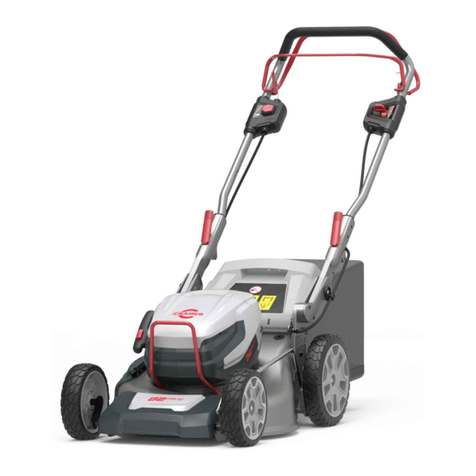
Cramer
Cramer 82LM46S User manual

Cramer
Cramer 2502386 User manual
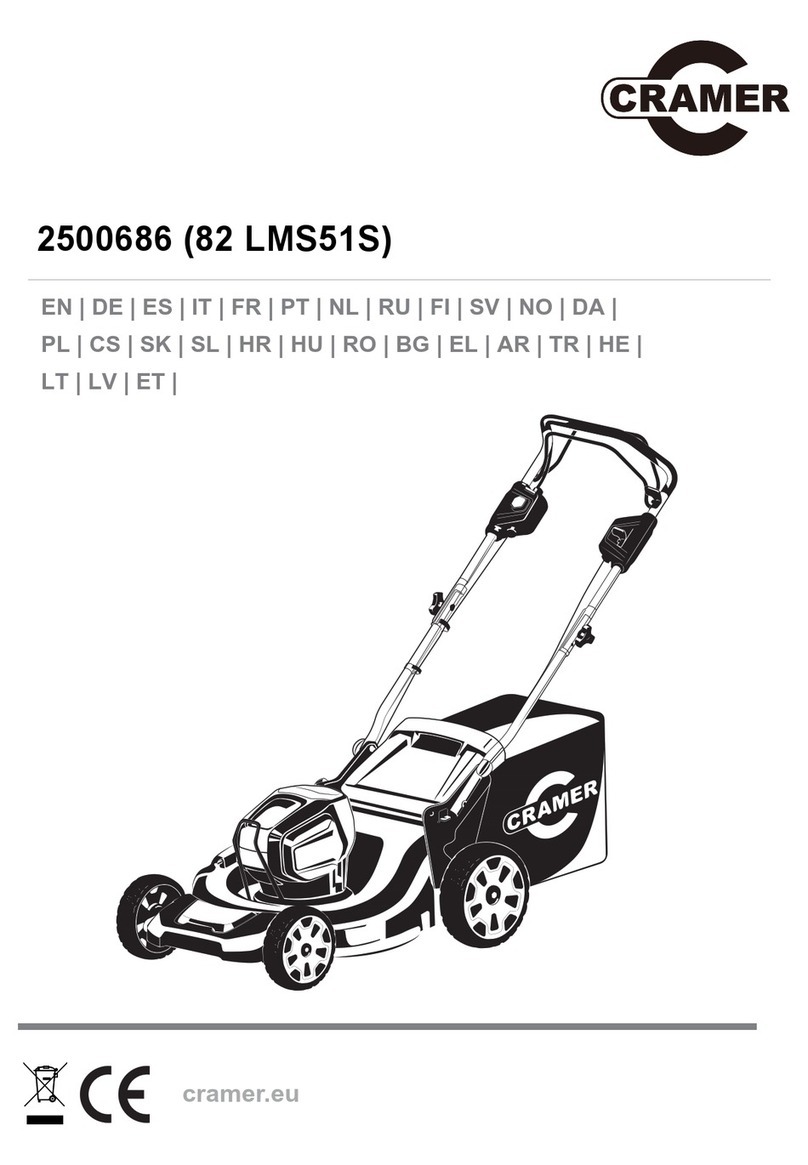
Cramer
Cramer 2500686 User manual
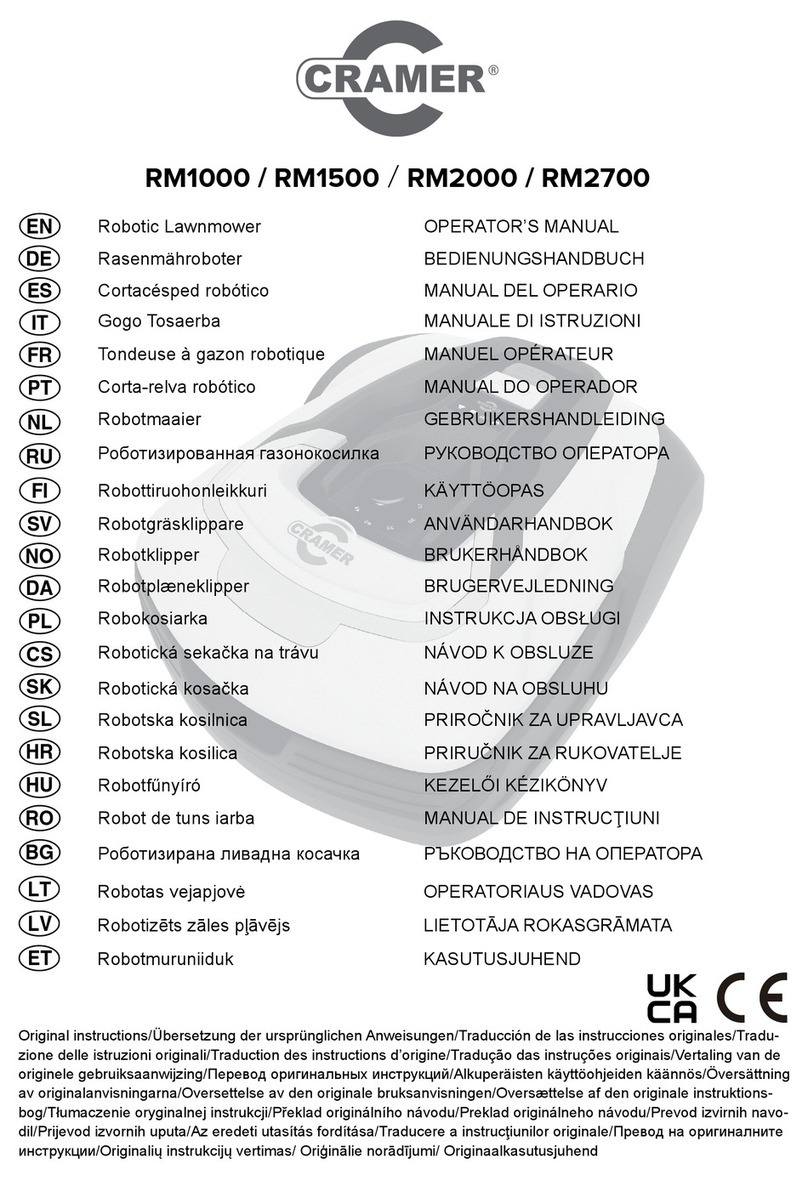
Cramer
Cramer RM1500 User manual
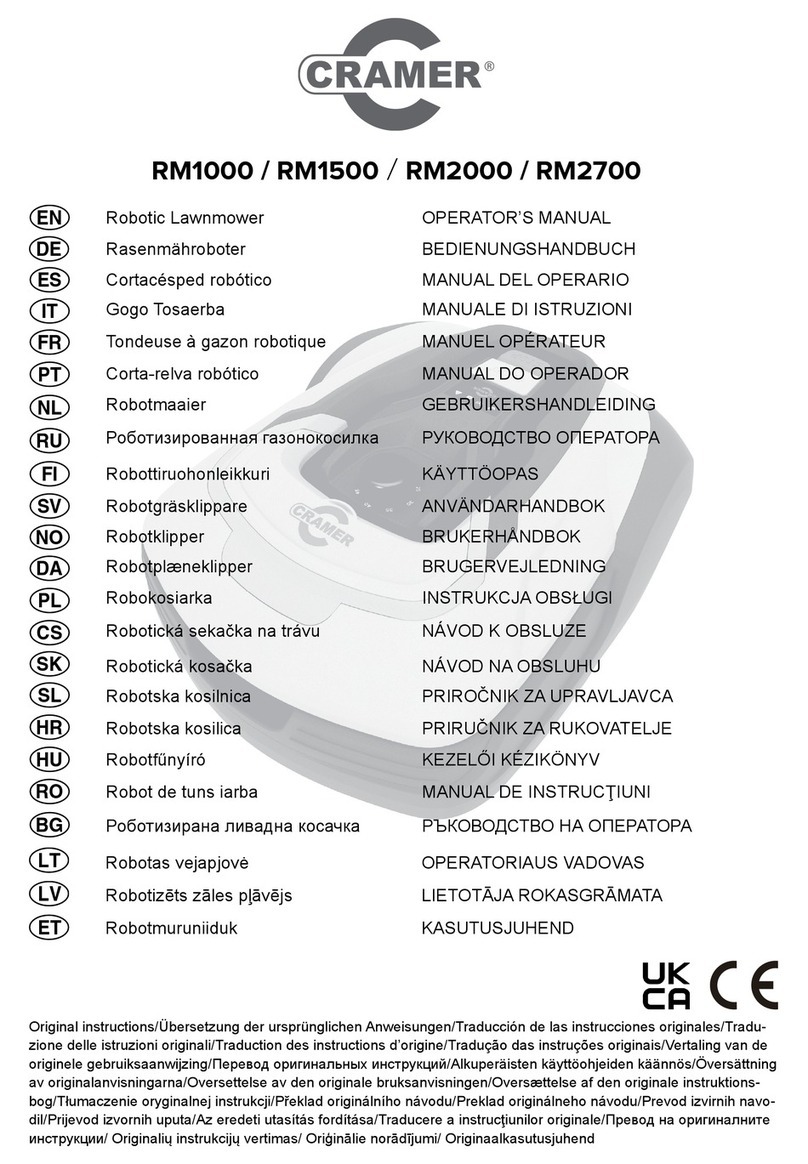
Cramer
Cramer RM2700 User manual
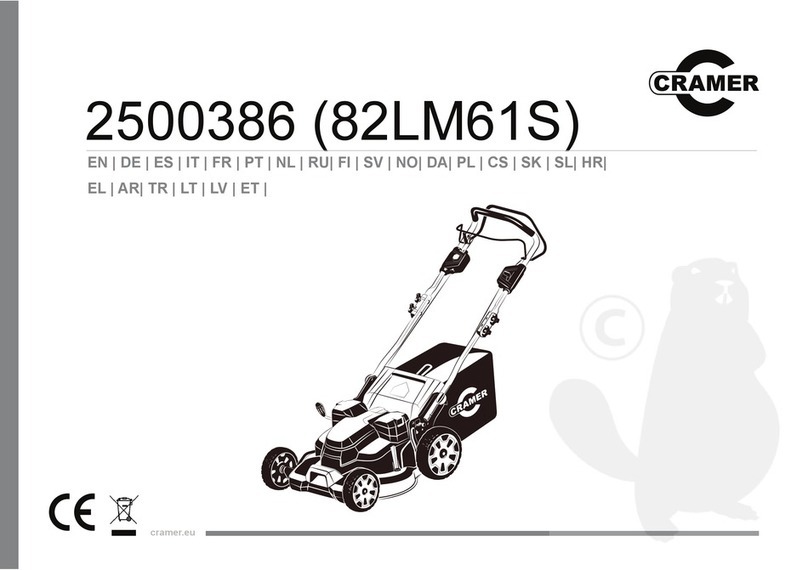
Cramer
Cramer 2500386 User manual

Cramer
Cramer 2502486 User manual
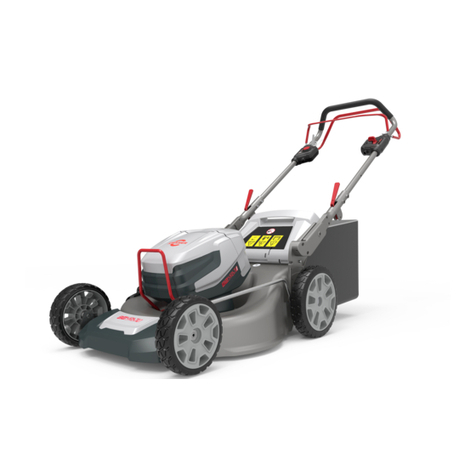
Cramer
Cramer 82 LMS51S User manual
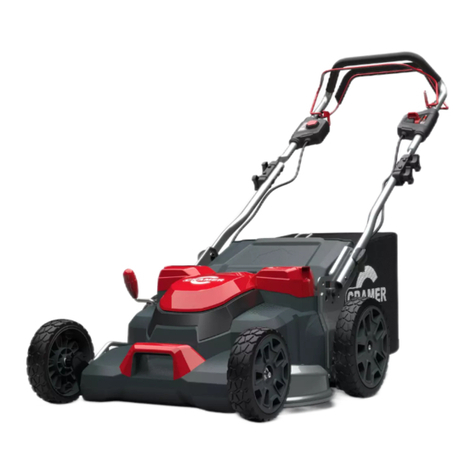
Cramer
Cramer 82LM61SX User manual

Cramer
Cramer 2501286 User manual
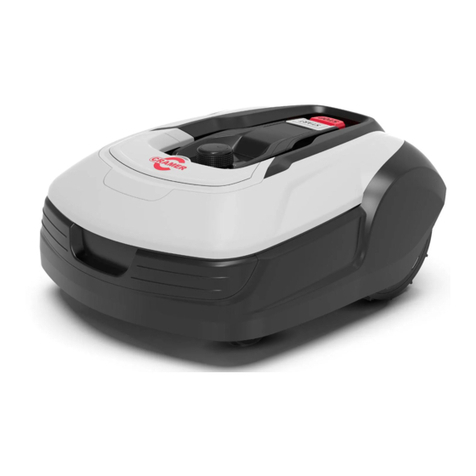
Cramer
Cramer RM1000 User manual

Cramer
Cramer 2502886 User manual
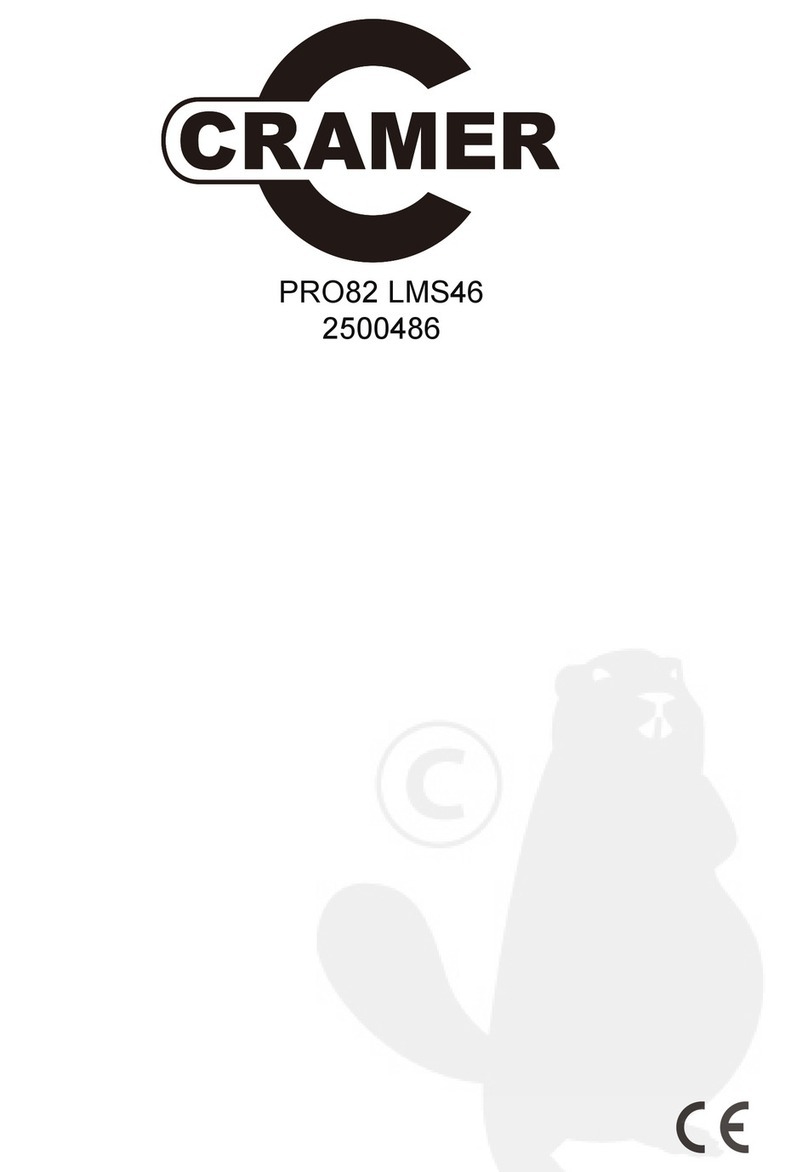
Cramer
Cramer PRO82 LMS46 User manual

Cramer
Cramer 40LM41 User manual
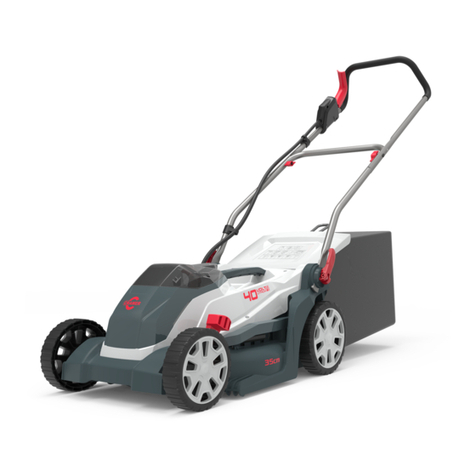
Cramer
Cramer 40LM35 User manual

Cramer
Cramer TOURNO de Luxe 95 User manual
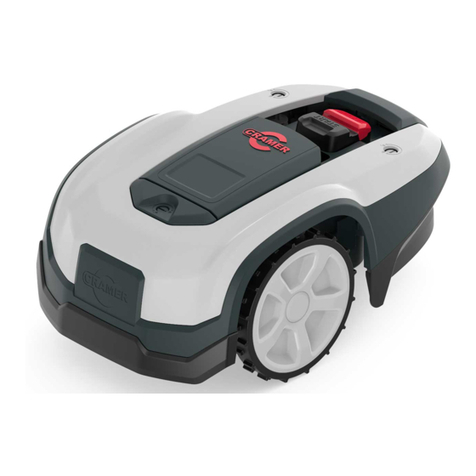
Cramer
Cramer RM800 User manual

Cramer
Cramer 40LM35 User manual
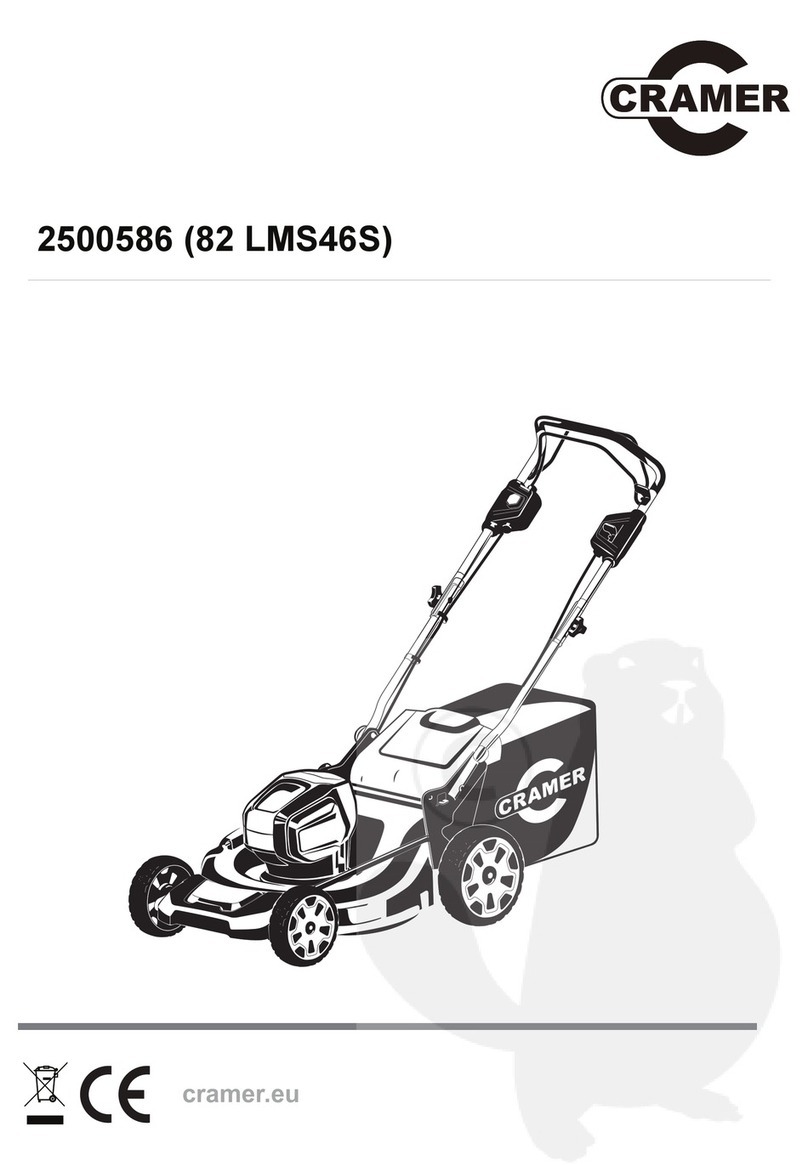
Cramer
Cramer 2500586 User manual
